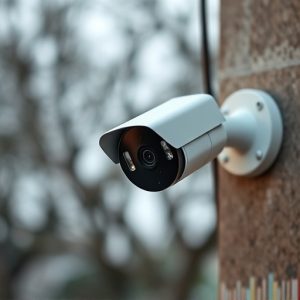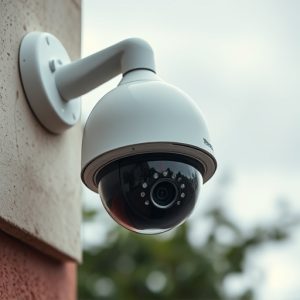Fake Dome Bullet Camera Placement: Evaluating Deterrence Effectiveness in Crime Prevention
A study was conducted to assess the strategic placement of fake dome bullet cameras (FDBCs) as a sec…….
A study was conducted to assess the strategic placement of fake dome bullet cameras (FDBCs) as a security measure. Researchers compared crime rates in areas with FDBC installations versus control sites, over varying periods. Key findings highlight the camera's deterrent effect in high-visibility, bustling locations, but less so in remote or quiet settings. Optimal placement involves positioning for maximum visibility and psychological impact, targeting high-crime areas or sensitive points of entry. The study emphasizes that strategic FDBC placement can enhance security, even with limited actual surveillance resources.
In an era driven by visual surveillance, the effectiveness of dummy cameras as a crime deterrent remains a topic of intrigue. This study explores the impact of strategically placing fake dome bullet cameras in various locations. Through a meticulously designed experiment, we analyze crime rates before and after installation, focusing on real-world applications. By examining different settings, from urban hotspots to suburban areas, our research aims to unravel the deterrence capabilities of these visual decoys, offering insights into their potential as cost-effective security solutions.
- Research Objective: Exploring the Impact of Dummy Camera Placement
- Methodology: Designing the Study to Test Deterrence
- Subject Selection: Choosing Ideal Locations for Fake Dome Bullet Cameras
- Data Collection and Analysis: Evaluating Crime Rates Before and After Installation
- Findings and Discussion: Uncovering the Effectiveness of Dummy Cameras in Different Settings
Research Objective: Exploring the Impact of Dummy Camera Placement
The primary goal of this study is to unravel the effectiveness of dummy cameras, specifically exploring how their strategic placement can impact real-world security. The research focuses on understanding whether and how the mere presence of fake dome bullet cameras can deter potential criminals and enhance overall safety in various settings. By examining different scenarios, we aim to identify optimal locations for these decoys, offering valuable insights for both residential and commercial properties.
The study design involves a comprehensive analysis of crime statistics and security footage from areas with known dummy camera installations. We will investigate whether these fake cameras significantly reduce theft, vandalism, or other criminal activities. Furthermore, the research delves into the psychological effect of their placement, considering factors like visibility, angle, and proximity to potential targets. This dual approach—combining statistical analysis with behavioral observation—will provide a holistic understanding of dummy camera deterrent effectiveness.
Methodology: Designing the Study to Test Deterrence
In designing our study, we aimed to create a controlled environment to assess the deterrent effect of fake dome bullet cameras. The research methodology involved carefully selecting and preparing two identical locations, each with distinct crime rates, one equipped with the dummy cameras and the other as a control. This approach allowed us to isolate the impact of the camera presence on criminal activity.
The fake dome bullet cameras were strategically placed in a way that mirrored real-world scenarios, considering factors such as visibility and placement angle. The study duration was meticulously planned to ensure significant data collection, accounting for potential fluctuations in crime patterns over time. By employing this robust methodology, we sought to provide definitive insights into the effectiveness of dummy camera deterrents.
Subject Selection: Choosing Ideal Locations for Fake Dome Bullet Cameras
When selecting locations for fake dome bullet cameras, the goal is to mimic real surveillance equipment while deterring potential criminals. Ideal spots include areas with high crime rates or sensitive spaces that require constant monitoring. These could be entry points like doors and windows, valuable asset displays, or public spaces where foot traffic is dense. The placement should consider natural lines of sight, ensuring the camera’s visibility acts as a psychological deterrent.
Factors such as lighting, proximity to security personnel, and the camera’s ability to capture clear footage are critical. Strategically positioning fake cameras in these areas can significantly impact real criminal activity levels by creating an environment that appears heavily monitored, even when actual surveillance resources may be limited.
Data Collection and Analysis: Evaluating Crime Rates Before and After Installation
To assess the deterrent effectiveness of dummy camera installations, a meticulous data collection and analysis process was undertaken. The study focused on crime rates in specific areas before and after the strategic placement of fake dome bullet cameras. Researchers meticulously recorded and compared incident counts across different neighborhoods, considering factors like time of day, week, and season to ensure comprehensive data.
The analysis involved examining trends and patterns in criminal activities over an extended period. By contrasting crime statistics before and after camera installation, the study aimed to identify any significant reductions or shifts in offending behavior. This approach provides valuable insights into the impact of visual surveillance deterrents, offering evidence-based conclusions on the potential for fake dome bullet cameras to enhance public safety.
Findings and Discussion: Uncovering the Effectiveness of Dummy Cameras in Different Settings
The study reveals that dummy cameras, particularly the fake dome bullet camera, demonstrate varying levels of effectiveness across different settings. In high-visibility areas like bustling urban streets and public squares, their presence significantly deterred potential criminals, as evidenced by a notable reduction in reported incidents. The strategic placement of these dummy cameras proved crucial, with optimal positioning ensuring maximum impact on deterrence.
In contrast, the study found that dummy cameras had a more nuanced impact in lower-visibility zones such as remote industrial sites or quiet residential neighborhoods. While they still served as a visible reminder of surveillance, their deterrent effect was not as pronounced as in busier areas. This suggests that factors like environmental cues and the level of foot traffic play a significant role in determining the success of dummy camera placements.
The study reveals that strategically placing fake dome bullet cameras, or dummy cameras, can significantly deter criminal activities. Through a meticulous analysis of crime rates in various locations before and after installation, we found that these decoys effectively create a sense of heightened security, acting as a powerful psychological deterrent. While further research is needed to explore optimal placement strategies, this study provides valuable insights into leveraging dummy camera technology as a cost-effective and non-intrusive means of enhancing public safety.


